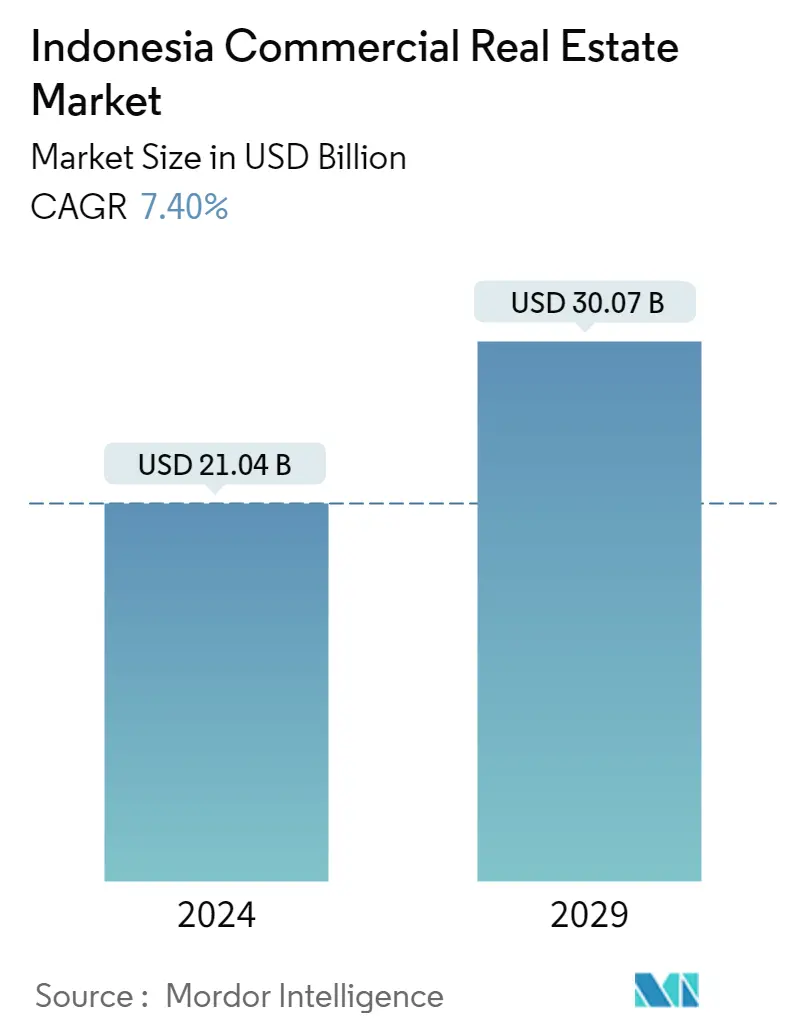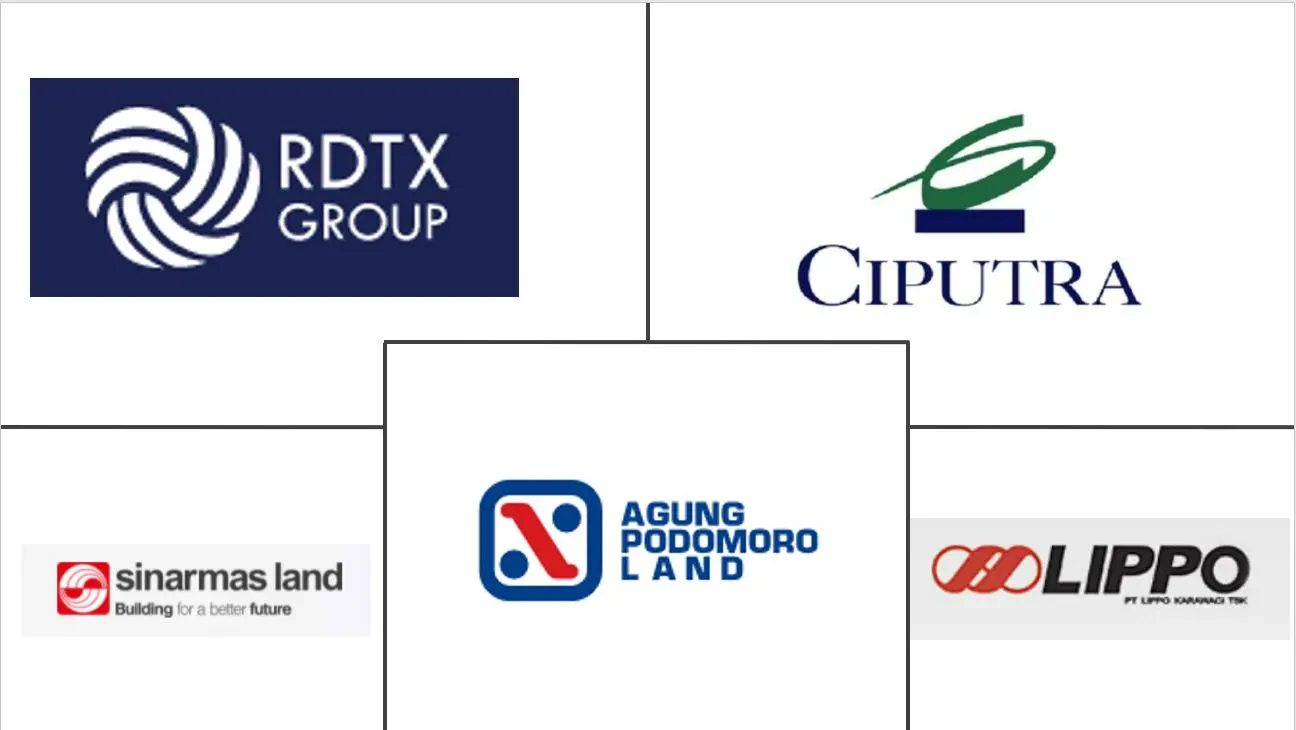Market Size of Indonesia Commercial Real Estate Industry

| Study Period | 2020 - 2029 |
| Base Year For Estimation | 2023 |
| Market Size (2024) | USD 21.04 Billion |
| Market Size (2029) | USD 30.07 Billion |
| CAGR (2024 - 2029) | 7.40 % |
| Market Concentration | Low |
Major Players
*Disclaimer: Major Players sorted in no particular order |
Need a report that reflects how COVID-19 has impacted this market and its growth?
Indonesia Commercial Real Estate Market Analysis
The Indonesia Commercial Real Estate Market size is estimated at USD 21.04 billion in 2024, and is expected to reach USD 30.07 billion by 2029, growing at a CAGR of 7.40% during the forecast period (2024-2029).
- The market is driven by the country's rapid population growth and high urbanization. The long-term outlook for commercial real estate looks positive for Indonesia, supported by solid economic growth and rising urbanization. The COVID-19 pandemic had a significant impact on the commercial real estate (CRE) sector in Indonesia. Commercial property transaction volumes and prices fell in 2020 as pandemic containment measures harmed economic activity and reduced demand for commercial property.
- Some markets, particularly in Asia, quickly rebounded from the initial shock, but long-term social distance limitations reduced occupier demand in the country's economy, contributing to a growing disparity in CRE prices across Indonesia and CRE segments (such as retail, office buildings, industrial, and multi-family buildings).
- Average land prices in Indonesia have been growing across the country. Prices continue to be highest in the capital city, Jakarta, which is the economic center of Indonesia.
- There is still much room for further developments to fulfill the demand for commercial real estate. To meet the rising property demand, the Indonesian government introduced several measures to expand the sector, such as decreasing key interest rates, providing tax incentives to Indonesian real estate investment trusts, and increasing the loan-to-value ratios.
- The Indonesian government authorized a budget of IDR 2.7 quadrillion (USD 190.1 billion) for 2022 in September 2021, with IDR 1.9 quadrillion (USD 133.8 billion) going to the central government and IDR 770 trillion (USD 54.2 billion) going the regional administration. Simultaneously, the government announced intentions in the budget to allocate IDR 384.8 trillion (USD 27.1 billion) to infrastructure.
Indonesia Commercial Real Estate Industry Segmentation
Commercial real estate, investment property, or income property is intended to generate a profit, either from capital gains or rental income. This report aims to provide a detailed analysis of the Indonesian commercial real estate market. The Indonesian commercial real estate market is segmented by type (offices, retail, industrial, logistics, multi-family, and hospitality) and key cities (Jakarta, Surabaya, and Semarang). The report offers market size and forecast values (USD billion) for all the above segments.
| By Type | |
| Offices | |
| Retail | |
| Industrial | |
| Logistics | |
| Multi-family | |
| Hospitality |
| By Key Cities | |
| Jakarta | |
| Surabaya | |
| Semarang |
Indonesia Commercial Real Estate Market Size Summary
The commercial real estate market in Indonesia is poised for significant growth, driven by rapid population increase and urbanization. Despite the challenges posed by the COVID-19 pandemic, which initially led to a decline in property transaction volumes and prices, the market has shown resilience. The pandemic's impact varied across different segments, such as retail, office buildings, industrial, and multi-family properties, creating disparities in pricing. The Indonesian government has implemented measures to stimulate the sector, including reducing key interest rates, offering tax incentives, and increasing loan-to-value ratios. These efforts, coupled with the country's robust economic growth, are expected to support the market's expansion over the forecast period.
The market landscape is characterized by a fragmented structure with numerous local players, including prominent companies like Agung Podomoro Land, Sinarmas Land, and Lippo Karawaci. The Jakarta CBD office market has begun to recover, with positive net-take-up rates indicating a rebound. The retail sector in Jakarta has also seen new developments, such as the addition of AEON Mall Tanjung Barat, contributing to the market's stability. The entry of international companies, like Equinix, into the Indonesian market highlights the growing investment interest. Overall, the commercial real estate sector in Indonesia is expected to experience increased investments and activity, driven by both local and international players.
Indonesia Commercial Real Estate Market Size - Table of Contents
-
1. MARKET INSIGHTS AND DYNAMICS
-
1.1 Current Market Overview
-
1.2 Market Dynamics
-
1.2.1 Drivers
-
1.2.2 Restraints
-
1.2.3 Opportunities
-
-
1.3 Industry Attractiveness - Porters 5 Force Analysis
-
1.3.1 Threat of New Entrants
-
1.3.2 Bargaining Power of Buyers/Consumers
-
1.3.3 Bargaining Power of Suppliers
-
1.3.4 Threat of Substitute Products
-
1.3.5 Intensity of Competitive Rivalry
-
-
1.4 Commercial Real Estate Buying Trends - Socioeconomic and Demographic Insights
-
1.5 Government Initiatives and Regulatory Aspects for the Commercial Real Estate Sector
-
1.6 Insights into Existing and Upcoming Projects
-
1.7 Insights into Interest Rate Regime for the General Economy and Real Estate Lending
-
1.8 Insights into Rental Yields in the Commercial Real Estate Segment
-
1.9 Insights into Capital Market Penetration and REIT Presence in Commercial Real Estate
-
1.10 Insights into Public-Private Partnerships in Commercial Real Estate
-
1.11 Insights into Real Estate Tech and Startups Active in the Real Estate Segment (Broking, Social Media, Facility Management, and Property Management)
-
-
2. MARKET SEGMENTATION
-
2.1 By Type
-
2.1.1 Offices
-
2.1.2 Retail
-
2.1.3 Industrial
-
2.1.4 Logistics
-
2.1.5 Multi-family
-
2.1.6 Hospitality
-
-
2.2 By Key Cities
-
2.2.1 Jakarta
-
2.2.2 Surabaya
-
2.2.3 Semarang
-
-
Indonesia Commercial Real Estate Market Size FAQs
How big is the Indonesia Commercial Real Estate Market?
The Indonesia Commercial Real Estate Market size is expected to reach USD 21.04 billion in 2024 and grow at a CAGR of 7.40% to reach USD 30.07 billion by 2029.
What is the current Indonesia Commercial Real Estate Market size?
In 2024, the Indonesia Commercial Real Estate Market size is expected to reach USD 21.04 billion.

